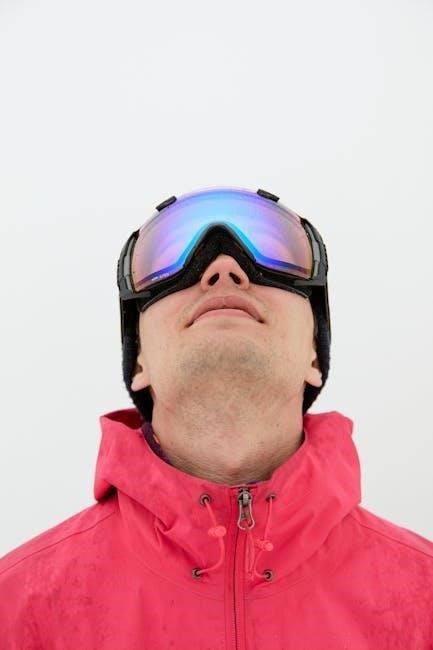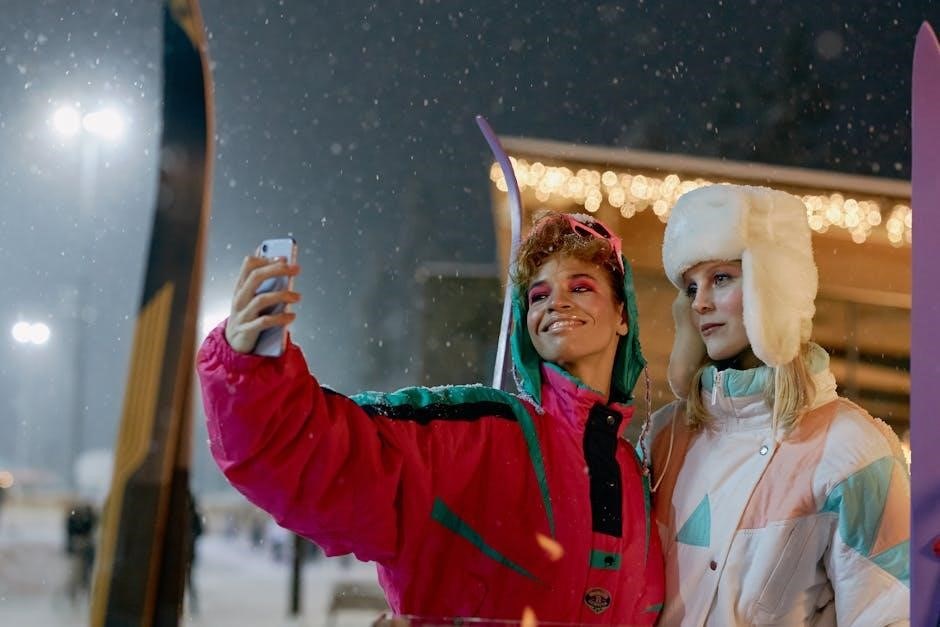Ski goggle lens colors play a crucial role in enhancing visibility and protection for skiers and snowboarders. Different tints are designed to optimize vision in varying light conditions, ensuring clarity and contrast. Lens colors help reduce glare, improve depth perception, and protect eyes from harmful UV rays. Understanding the right tint for specific environments is essential for a safer and more enjoyable experience on the slopes.
1.1 Importance of Lens Color in Skiing and Snowboarding
Lens color is crucial in skiing and snowboarding for protecting eyes from UV rays and reducing glare. It enhances visual clarity by optimizing contrast and reducing eye strain. The right tint improves depth perception and reduces glare, essential for safety and performance in varying light conditions, ensuring a safer and more enjoyable experience on the slopes.
1.2 Brief Overview of Popular Lens Tints
Popular ski goggle lens tints include amber, rose, violet, blue, clear, and yellow. Amber and rose enhance contrast in low light, while violet and blue reduce glare. Clear and yellow lenses excel in flat light, offering maximum visibility. Each tint is tailored to specific conditions, ensuring optimal clarity and protection for skiers and snowboarders in varying environments.
Understanding VLT (Visible Light Transmission)
Visible Light Transmission (VLT) measures how much light passes through a lens, impacting visibility in various skiing conditions. Higher VLT allows more light, enhancing low-light vision, while lower VLT reduces glare in bright settings, optimizing visual clarity for skiers and snowboarders.
2.1 What is VLT and How Does it Affect Vision?
Visible Light Transmission (VLT) measures the percentage of light passing through a lens, affecting how skiers perceive their environment. Higher VLT enhances low-light visibility, while lower VLT reduces glare in bright conditions. Proper VLT balances clarity and comfort, ensuring optimal vision for skiing and snowboarding across varying light scenarios, making it a key factor in lens selection for performance and safety.
2.2 VLT Percentages and Their Suitability for Different Conditions
Higher VLT percentages (60-80%) enhance visibility in low-light or flat-light conditions, while lower VLT (10-30%) reduces glare in bright, sunny environments. Medium VLT (40-60%) balances light transmission for overcast or snowy days. Choosing the right VLT ensures optimal clarity, contrast, and comfort, tailored to specific skiing or snowboarding conditions for improved performance and safety on the slopes.
Lens Colors for Specific Weather Conditions
Lens colors adapt to weather, enhancing visibility. Low light conditions benefit from clear or yellow lenses, while overcast or snowy days may prefer amber or rose.
3.1 Best Lens Colors for Low Light and Flat Light
In low and flat light conditions, amber and rose-tinted lenses are ideal. These tints enhance contrast, improving visibility and depth perception. Yellow lenses also perform well, reducing eye strain and brightening the environment. For overcast or snowy days, orange lenses can be beneficial, as they increase contrast and clarity. Proper lens choice ensures better performance and safety in challenging lighting scenarios on the slopes.
3.2 Lens Colors for Overcast and Snowy Conditions
For overcast and snowy conditions, orange and amber lenses are highly effective. These tints enhance clarity and contrast, reducing glare from snow. Yellow lenses also work well, providing better visibility in low-contrast environments. Additionally, violet and blue lenses can reduce glare, though they may not offer the same contrast enhancement. Proper lens selection ensures improved vision and safety in snowy and overcast settings.
3.3 Lens Colors for Sunny and Bright Conditions
In sunny and bright conditions, mirror-coated lenses like silver, gray, or black are ideal. These tints reduce glare and block intense UV rays, offering superior protection. Darker lenses also minimize light intensity, improving visibility on the snow. For enhanced performance, polarized lenses can further reduce glare from reflective surfaces, ensuring clearer vision and comfort in bright environments.
The Impact of Lens Color on Contrast and Glare
Specific ski goggle lens tints enhance contrast and depth perception, while mirror and polarized coatings reduce glare and reflections, improving overall visual clarity on the slopes.
4.1 How Different Tints Enhance or Reduce Contrast
Different lens tints alter how light is perceived, enhancing or reducing contrast. Amber and rose lenses amplify contrast in low-light conditions, improving definition. Mirror-coated and violet/blue lenses minimize glare and reflections, reducing eye strain in bright settings. These variations optimize visual clarity, helping skiers discern terrain details more effectively, regardless of lighting conditions on the mountain.
4.2 Reducing Glare with Polarized and Mirror-Coated Lenses
Polarized lenses reduce glare from reflective surfaces like snow and water by filtering out horizontal light waves. Mirror-coated lenses reflect light away, minimizing glare in bright conditions. Both technologies enhance visibility and reduce eye strain, making them ideal for sunny or icy environments. These coatings are essential for improving comfort and clarity during outdoor adventures on the slopes or trails.

Popular Lens Color Options and Their Benefits
Amber and rose lenses enhance contrast, while violet and blue reduce glare. Clear and yellow lenses excel in low-light conditions, improving visibility and comfort for skiers.
5.1 Amber and Rose Lenses for Enhanced Contrast
Amber and rose lenses are designed to enhance contrast, making it easier to see variations in snow texture and depth. These tints are ideal for low-light and flat-light conditions, improving visibility by amplifying available light. They reduce eye strain and provide sharper visuals, helping skiers navigate challenging terrains with greater confidence and precision.
5.2 Violet and Blue Lenses for Reduced Glare
Violet and blue lenses are designed to reduce glare, particularly in bright, sunny conditions. These tints help minimize eye strain caused by reflective snow surfaces. Blue lenses enhance visual acuity in high-light environments, while violet lenses can improve contrast and reduce harsh light reflections. Both options are ideal for skiers seeking clarity and comfort in sunny, glacier-like conditions.
5.3 Clear and Yellow Lenses for Low Light Conditions
Clear and yellow lenses are optimal for low-light conditions, providing maximum visibility without altering color perception. Clear lenses allow the most light transmission, ideal for overcast or snowy days, while yellow lenses enhance contrast and reduce eye strain. Both options are essential for skiers and snowboarders navigating flat light or cloudy environments, ensuring better performance and safety on the mountain.

Additional Features to Consider
When selecting ski goggles, consider features like UV protection, anti-fog coatings, and mirror finishes. These enhance optical clarity, reduce glare, and protect lenses from scratches, ensuring durability and performance.
6.1 UV Protection and Anti-Fog Coatings
UV protection is essential for skiing, as it shields eyes from harmful UV rays. Anti-fog coatings prevent moisture buildup, ensuring clear vision in humid conditions. These features are vital for optimal performance, reducing eye strain and enhancing safety on the slopes. Always look for goggles with built-in UV protection and anti-fog layers to maintain unobstructed visibility during your winter adventures.
6.2 Mirror Coatings and Their Advantages
Mirror coatings on ski goggle lenses offer enhanced glare reduction and UV protection. They reflect light, minimizing eye strain in bright conditions. These coatings also improve visual clarity and add a stylish touch. Mirror-coated lenses are ideal for sunny days, providing both functional benefits and a modern aesthetic appeal. They are a popular choice for skiers seeking optimal performance and style on the slopes.
How to Choose the Right Lens for Your Needs
Selecting the right ski goggle lens involves assessing your skiing environment, light conditions, and personal preferences. Consider factors like VLT, weather, and style to ensure optimal performance and comfort on the slopes.
7.1 Assessing Your Skiing Environment and Conditions
Evaluate the lighting, weather, and terrain you typically encounter. For low-light or flat-light conditions, opt for high VLT lenses with tints like amber or rose. In sunny or bright environments, choose lower VLT options with mirror coatings to reduce glare. Consider overcast or snowy conditions, where orange or yellow lenses enhance contrast. Match your lens to the specific demands of your skiing habitat for optimal clarity and performance.
7.2 Balancing Style, Functionality, and Performance
Combine personal style with functional needs by selecting lenses that match your skiing conditions and aesthetic preferences. While high-performance features like UV protection and anti-fog coatings are essential, consider how lens colors complement your gear. Brands like Smith Optics and Oakley offer stylish options with advanced technologies, ensuring both visual appeal and superior performance on the slopes.

Maintenance and Care of Ski Goggle Lenses
Proper maintenance ensures longevity and clarity of ski goggle lenses. Use a microfiber cloth to clean lenses, avoiding paper towels or abrasive materials. Store goggles in a protective case to prevent scratches and extend their lifespan.
8.1 Cleaning and Storing Your Lenses Properly
Proper care ensures clarity and longevity. Clean lenses with a microfiber cloth, avoiding paper towels or harsh chemicals. Gently wipe from one side to the other, removing dirt and smudges. Store goggles in a protective case or pouch to prevent scratches. Keep them in a dry, cool place to avoid moisture buildup. Regular cleaning and proper storage maintain optical clarity and prevent damage.
8.2 Avoiding Common Mistakes That Damage Lenses
Avoid using paper towels, sleeves, or rough cloths to clean lenses, as they can scratch the surface. Never touch the lens with bare hands, as oils can leave smudges. Avoid exposing goggles to extreme temperatures or improper storage, which can warp frames or damage coatings. Always use a microfiber cloth and store lenses in a protective case to maintain clarity and prevent damage.

Top Brands and Their Lens Color Offerings
Top brands like Smith Optics and Oakley offer high-quality goggle lenses. Smith Optics features ChromaPop technology for enhanced color clarity, while Oakley’s Prizm lenses provide specialized tints for various conditions, ensuring optimal performance and style for every skiing need.
9.1 Smith Optics and Their ChromaPop Technology
Smith Optics revolutionizes ski goggle lenses with their ChromaPop technology, enhancing color clarity and definition. This innovative tech filters light to reduce glare and optimize visibility in various conditions. Smith’s I/O MAG XL Goggles feature impact-resistant, anti-fog lenses with a secure fit, ensuring superior protection and unobstructed views for skiers and snowboarders.
9.2 Oakley and Their Prizm Lens Technology
Oakley’s Prizm lens technology enhances contrast and reduces glare, optimizing vision in snowy environments. Designed to improve visual performance, Prizm lenses filter light to emphasize textures and colors, making it easier to discern terrain details. This technology is tailored for specific conditions, ensuring clarity and precision for skiers and snowboarders, while maintaining Oakley’s reputation for innovative, high-performance eyewear.
10.1 Summary of Key Points
10.2 Emerging Technologies in Ski Goggle Lenses
Emerging technologies in ski goggle lenses include adaptive tints like photochromic lenses, which change color based on light conditions, and advanced mirror coatings for reduced glare. Brands like Smith Optics and Oakley are pioneering ChromaPop and Prizm technologies, enhancing color clarity and contrast. These innovations improve visibility, reduce eye strain, and offer customizable options for optimal performance in varying snow and light conditions.
